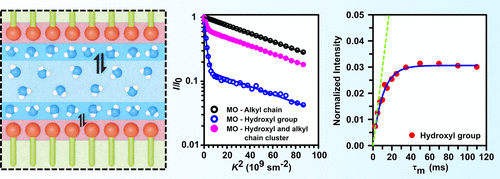当前位置:
X-MOL 学术
›
J. Phys. Chem. B
›
论文详情
Our official English website, www.x-mol.net, welcomes your
feedback! (Note: you will need to create a separate account there.)
Chemical Exchange of Hydroxyl Groups in Lipidic Cubic Phases Characterized by NMR
The Journal of Physical Chemistry B ( IF 2.8 ) Pub Date : 2020-11-30 , DOI: 10.1021/acs.jpcb.0c08699 Thomas G. Meikle 1 , David W. Keizer 2 , Jeffrey J. Babon 3, 4 , Calum J. Drummond 1 , Frances Separovic 2, 5 , Charlotte E. Conn 1 , Shenggen Yao 2
The Journal of Physical Chemistry B ( IF 2.8 ) Pub Date : 2020-11-30 , DOI: 10.1021/acs.jpcb.0c08699 Thomas G. Meikle 1 , David W. Keizer 2 , Jeffrey J. Babon 3, 4 , Calum J. Drummond 1 , Frances Separovic 2, 5 , Charlotte E. Conn 1 , Shenggen Yao 2
Affiliation

|
Proton transportation in proximity to the lipid bilayer membrane surface, where chemical exchange represents a primary pathway, is of significant interest in many applications including cellular energy turnover underlying ATP synthesis, transmembrane mobility, and transport. Lipidic inverse bicontinuous cubic phases (LCPs) are unique membrane structures formed via the spontaneous self-assembly of certain lipids in an aqueous environment. They feature two networks of water channels, separated by a single lipid bilayer which approximates the geometry of a triply periodic minimal surface. When composed of monoolein, the LCP bilayer features two glycerol hydroxyl groups at the lipid–water interface which undergo exchange with water. Depending on the conditions of the aqueous solution used in the formation of LCPs, both resonances of the glycerol hydroxyl groups may be observed by solution 1H NMR. In this study, PFG-NMR and 1D EXSY were employed to gain insight into chemical exchange between the monoolein hydroxyl groups and water in LCPs. Results including the relative population of hydroxyl protons in exchange with water for a number of LCPs at different hydration levels and the exchange rate constants at 35 wt % hydration are reported. Several technical aspects of PFG-NMR and EXSY-NMR for the characterization of chemical exchange in LCPs are discussed, including an alternative way to analyze PFG-NMR data of exchange systems which overcomes the inherent low sensitivity at high diffusion encoding.
中文翻译:

核磁共振表征脂质立方相中羟基的化学交换
质子在脂质双层膜表面附近的质子运输(化学交换是主要途径)在许多应用中引起了极大的兴趣,包括ATP合成,跨膜迁移和运输所基于的细胞能量转换。脂质逆双连续立方相(LCP)是通过某些脂质在水性环境中自发自组装而形成的独特膜结构。它们具有两个水通道网络,由单个脂质双层隔开,该脂质双层近似三重周期性最小表面的几何形状。当由单油精组成时,LCP双层在脂质-水界面处具有两个甘油羟基,并与水交换。根据用于形成LCP的水溶液的条件,1 H NMR。在这项研究中,PFG-NMR和1D EXSY被用于深入了解LCP中单油精羟基与水之间的化学交换。报告了结果,包括在不同水合水平下许多LCP与水交换的羟基质子的相对数量,以及水合含量为35 wt%时的交换常数。讨论了用于表征LCP中化学交换的PFG-NMR和EXSY-NMR的几个技术方面,包括分析交换系统PFG-NMR数据的另一种方法,该方法克服了高扩散编码时固有的低灵敏度。
更新日期:2021-01-21
中文翻译:

核磁共振表征脂质立方相中羟基的化学交换
质子在脂质双层膜表面附近的质子运输(化学交换是主要途径)在许多应用中引起了极大的兴趣,包括ATP合成,跨膜迁移和运输所基于的细胞能量转换。脂质逆双连续立方相(LCP)是通过某些脂质在水性环境中自发自组装而形成的独特膜结构。它们具有两个水通道网络,由单个脂质双层隔开,该脂质双层近似三重周期性最小表面的几何形状。当由单油精组成时,LCP双层在脂质-水界面处具有两个甘油羟基,并与水交换。根据用于形成LCP的水溶液的条件,1 H NMR。在这项研究中,PFG-NMR和1D EXSY被用于深入了解LCP中单油精羟基与水之间的化学交换。报告了结果,包括在不同水合水平下许多LCP与水交换的羟基质子的相对数量,以及水合含量为35 wt%时的交换常数。讨论了用于表征LCP中化学交换的PFG-NMR和EXSY-NMR的几个技术方面,包括分析交换系统PFG-NMR数据的另一种方法,该方法克服了高扩散编码时固有的低灵敏度。











































 京公网安备 11010802027423号
京公网安备 11010802027423号